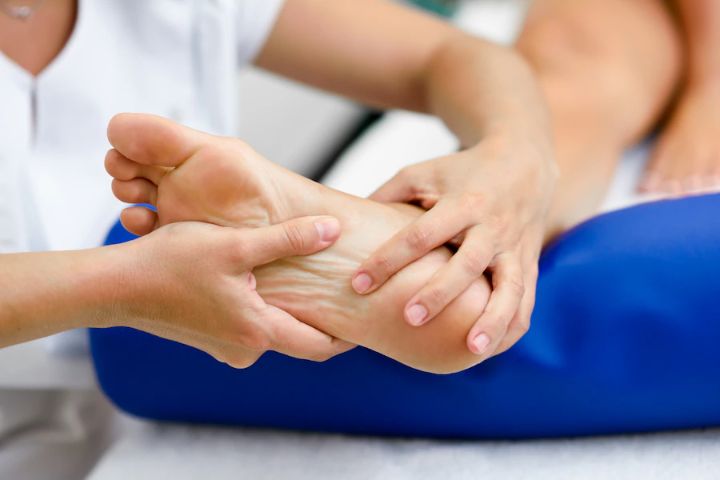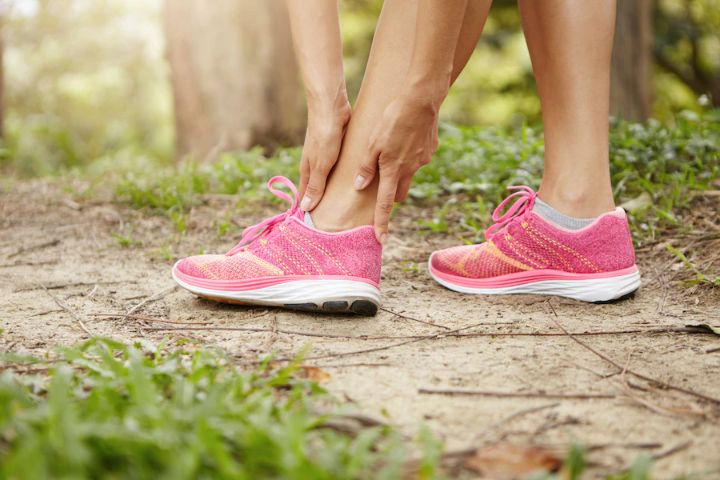Metatarsalgia is a condition characterized by pain and inflammation in the ball of the foot. It’s often caused by prolonged activities, ill-fitting shoes, or foot deformities that place excessive pressure on the metatarsal bones.
Treatment typically involves rest, footwear adjustments, and sometimes orthotic inserts to relieve pain.
You may experience a variety of symptoms if you have metatarsalgia, including pain, inflammation, and tenderness.
Pain is often felt in the front part of the foot or toes and can range from dull to sharp. It usually worsens when walking or standing for long periods of time.
Inflammation may be seen as swelling around the ball-of-foot area and can make shoes feel too tight.
Tenderness can occur in both the ball-of-foot area and toes, especially upon pressure or touching. Additionally, burning sensations in the affected area are common with metatarsalgia.
If left untreated, it could lead to other complications such as hammertoe deformity or corns on your feet.
Diagnosing metatarsalgia can be a tricky process as the symptoms are often very similar to those of other foot conditions. To accurately diagnose this condition, your doctor will likely ask about your symptoms and examine your feet.
They may also order diagnostic tests such as X-rays or an MRI to identify any underlying issues.
Identifying metatarsalgia symptoms usually involves palpating the affected area. You may notice pain in the ball of your foot that worsens when you walk or stand for an extended period of time. Pain may also be felt when you press on the area, and it can radiate to your toes.

Photo Credit: javi_indy
Other common symptoms include burning sensations, numbness, tingling, or a feeling of having a pebble in your shoe even though there is none present. In some cases, calluses or blisters may form on the bottom of your foot due to excessive rubbing against footwear.
If these symptoms are not addressed promptly, they can lead to further complications such as hammertoes or bunions.
To accurately assess what’s causing your foot pain, your doctor may perform certain tests to diagnose the issue. These tests include an X-ray, a physical exam, and an ultrasound scan.
An X-ray can reveal calcium deposits or any other structural deformities that could be contributing to metatarsalgia.
During a physical exam, the doctor will feel around your foot for swelling and tenderness as well as test your range of motion in order to identify where the pain originates from. An ultrasound scan can show if there is any inflammation present.
These tests are important for ruling out any other medical conditions that could be causing similar symptoms such as plantar fasciitis or tendonitis. With these tests, your doctor can better understand what’s causing your discomfort and provide targeted treatment accordingly.
Common causes of metatarsalgia include overexertion, ill-fitting shoes, and injuries.
Overexertion occurs when the feet are under too much stress or pressure, such as running or playing sports.
Ill-fitting shoes can cause pain in the forefoot area because they don’t provide enough support for your foot.
Injuries to the foot, such as a fracture, dislocation, or tendon rupture can also lead to this condition.
Poorly designed footwear that doesn’t have arch support or cushioning can increase the risk of developing this condition.

Photo Credit: wayhomestudio
Additionally, having bunions and hammertoes can put extra strain on the ball of your foot and lead to metatarsalgia.
Having an uneven gait due to leg length discrepancies is another potential cause for this type of foot pain.
Treating metatarsalgia often begins with assessing the underlying cause and making necessary lifestyle changes, such as wearing appropriate shoes and avoiding overexertion.
Other steps may include resting the foot and using ice to reduce pain and swelling, taking over-the-counter medication for pain relief, and doing strengthening exercises to support the foot’s arch and stretching exercises to increase flexibility in the toes.
A doctor may recommend orthotic inserts or padding for your shoes in more severe cases. Surgery is rarely required but may be necessary if other treatments fail.
To prevent metatarsalgia, it’s important to pay attention to your footwear choices and exercise habits.
Wearing supportive shoes that provide good cushioning and arch support can help reduce the pressure on the ball of your foot.
Additionally, exercises that strengthen the muscles in your feet, such as calf raises and toe curls, can also help reduce foot pain caused by metatarsalgia.
Choosing the right footwear for your feet is key to reducing metatarsalgia symptoms. Opting for shoes that provide cushion and support, such as those made of leather or canvas, can help to reduce pressure on the ball of your foot.

Photo Credit: Freepik
Here are some other tips:
Maintaining healthy exercise habits can help reduce the discomfort of metatarsalgia. That means stretching your feet and legs regularly, as well as doing exercises that strengthen the muscles around your feet.
Avoid any activities that cause pain or put too much pressure on your metatarsal bones. Low-impact exercises like swimming, cycling, and yoga are particularly beneficial for people with metatarsalgia.
Pay attention to how you move while exercising; be aware of any tightness in your feet or ankles, and if necessary, take a break to adjust your position.
It’s also important to wear supportive footwear during exercise sessions. Arch supports can help redistribute weight away from the painful area of the foot and provide additional cushioning.
Dealing with metatarsalgia can be difficult, but there are ways you can manage your symptoms.
To help reduce pain and inflammation, try to wear shoes that fit properly and provide cushioning and support. Use orthotic devices or padding to support the foot. Take breaks throughout the day if standing or walking for a long period of time.
Avoid activities that put pressure on the affected area of the foot. Use crutches or other assistive devices when engaging in any activity. Talk with your doctor about medication options as well, such as non-steroidal anti-inflammatory drugs (NSAIDs).
Also, try icing the area for 10 minutes at least 3 times daily.
With these tips, you’ll be able to better cope with metatarsalgia!
The length of your symptoms will depend on the severity and cause of the condition. Generally, metatarsalgia can last for a few days or weeks with proper treatment.
No, metatarsalgia is not contagious. It is caused by overuse or injury to the bones and soft tissues in the ball of your foot.
Yes, there are lifestyle changes you can make to help relieve your symptoms. Try wearing more supportive shoes, using cushioned insoles, avoiding barefoot walking and high-impact activities like running and jumping, and taking breaks during long periods of standing or walking.
The long-term outcomes of metatarsalgia vary and can include chronic pain, difficulty walking or running, and increased pressure on other parts of the foot.
Yes, there are alternative treatments for metatarsalgia. You can try rest, massage therapy, taping the affected area and wearing comfortable shoes.